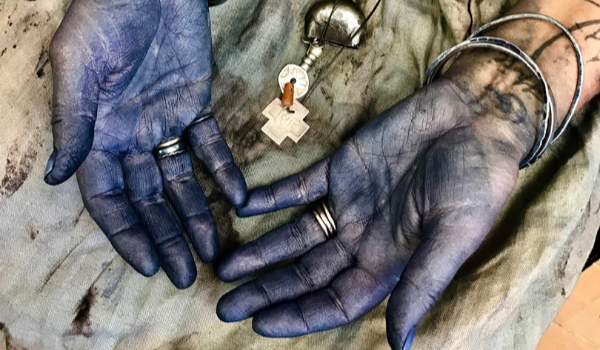
Incomplete Journeys

We've featured India Flint before in Selvedge. The textile artist, writer and storyteller has a way with colour and has done a great amount of work to promote the beauty of natural dyes. With the Festival of Quilts coming up this August, Julie Parmenter interviewed India about her work and the Festival:
Your farm in South Australia and the nature all around you are the source of much of the inspiration and raw materials for your work. How important is a sense of place to you personally and for the work you make?
It’s critical. In my work, the unique physical aspects of a place (water quality, local flora) are as important as my emotional experience of it. The farm I am fortunate to live on is a 500-acre open studio in which I roam, gather material and formulate concepts. But sometimes, pieces are prepared at home and then infused with local colour nearer to the place of exhibition. It all depends on what story I want to tell.
Is there a natural material that you have not yet worked with and are keen to explore?
Almost every plant in the world will yield some kind of colour…I haven’t even walked around the tip of the iceberg yet!

Photo by Sophena Kwon
Much of your work is wearable (aprons, coats) – how important is it to you that your art is functional?
I made wearables for a while (Halle Berry bought two of my dresses, bless her) but I only make clothes for myself now. I don’t really distinguish between clothing, bedding or wall adornments. They all perform important functions. Some warm the body, others the heart.
You famously validated your eco-print process (bundling leaves and other natural materials in damp silk cloths to produce unique, wash-fast prints) through a post-graduate research degree rather than patent it for commercial use. What was the thinking behind that decision?
I knew that many large international companies have employees whose job it is to trawl through new patents and harvest ideas. Such companies would be too large to fight, for one thing; but more importantly, I have observed that when anything is done on a large scale, the impact on the environment (even from something as supposedly “friendly” as this technique) can be disastrous. Imagine a company churning out thousands of pairs of eco-print pyjamas, delivering tonnes of waste leaf matter and discharging volumes of compromised water (all leaves are acidic, so will lower the pH of the water they are processed in). On a small scale, the leaf matter and water can be neutralised with a little ash before being distributed in a garden, but I cannot imagine a large fashion manufacturer caring much about this. Bad enough that the eco-print has been hijacked by the “plastics and toxins” brigade.

Through your School of Nomad Arts (and via the power of the internet), students all over the world are learning how to use your eco-print method to create their own work. How important is this community to you?
It’s proving to be a marvellously friendly and sharing community. People are seeking out stitch sisters in their region and meeting for tea and cake and sewing. And by using this wider means of teaching, it brings sustainable practice to so many more people, some of whom don’t have the means or the time to travel, or even to attend classes local to them. I have a warm feeling about this work.
Which textile artists do you think are making exciting work right now?
I am excited about each person who is moved to take up a needle and stitch, to mend a garment, to spin, knit or crochet, or to twine string. There is something about making things by hand that is good for the soul, and I have a strong belief that the deep satisfaction in making something for oneself can be a positive contributor to our physical and mental health. As far as contemporary artists go, I don’t think I have enough information to point at anyone in particular. I tend not to follow much of what’s going on.

Photo by Jacqui Way
What projects are you working on currently and what’s next for you after The Festival of Quilts?
At present, I am travelling in Morocco and stitching on a quilt-like piece made entirely from salvaged clothing recently acquired at a thrift store in New Orleans. It’s about 5’ x 6’ and very comfy to sit under while on a plane. I’ll probably dye it back home. I’m also working on my nine-month-long “armchair wandering” for the School of Nomad Arts. After The Festival of Quilts, I have workshops in France, Scotland and Canada, flowed by a residency at the Burren College of Art in Ireland. In 2020, I have a journey to India followed by three solo shows, all in Australia. And somewhere in between all that, there’s a novel that wants writing.
India Flint’s exhibition, incomplete journeys, is at The Festival of Quilts, NEC Birmingham, from 1 - 4 August 2019
Selvedge readers can get discounted tickets to the Festival of Quilts 2019. Simple book online and use the code SVG19 to receive £2 off standard advance adult/ £1 off advance concessions. This discount is for advanced bookings only and can be redeemed before 23:59 on Wednesday 31 August.
